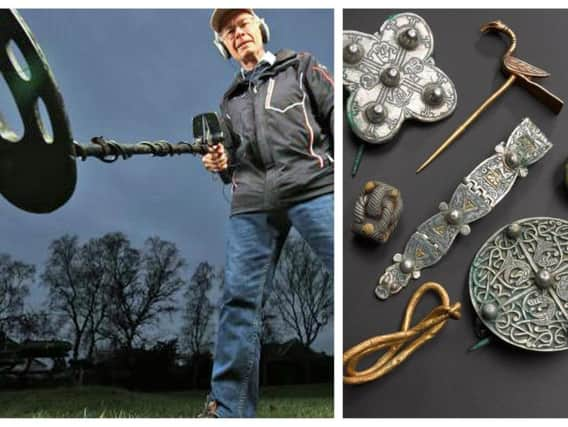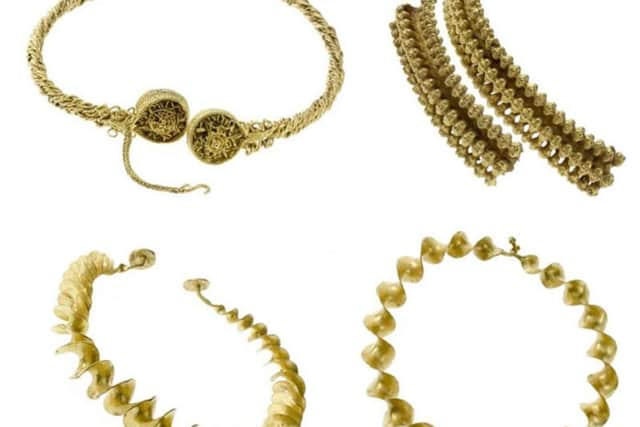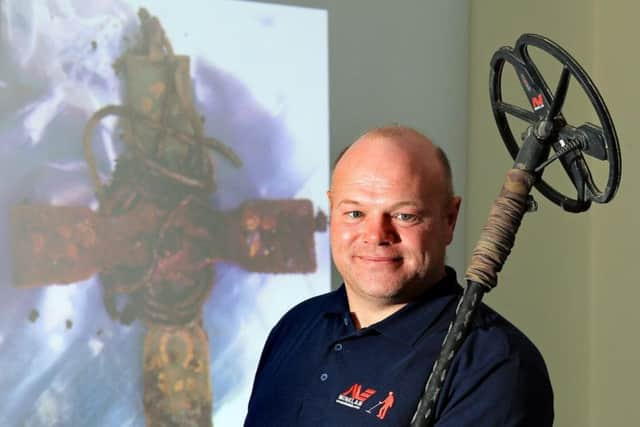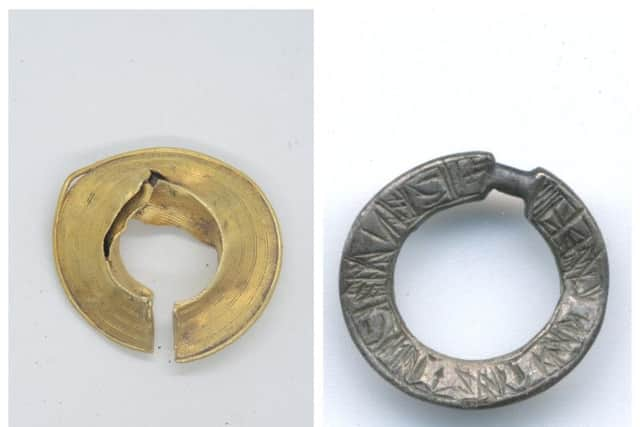The metal detectorists adding to Scotland's history one treasure at a time


Under the soil of Scotland lies traces of its history and the treasures of the nation’s past. Now, searching this soil is a growing number of metal detectorists, with membership of the main national organisation that guides the hobby reaching record levels.
Buoyed by incredible finds that have made headlines around the world, such as the discovery of the £1.98 million Viking-era Galloway hoard of silver and jewels, numbers of those taking up the hobby are on the rise.
Advertisement
Hide AdAdvertisement
Hide AdThe growing popularity of metal detecting is being met with a cautious welcome as well as an acknowledgement that Scotland’s history is being enhanced by those taking to muddy fields in search of pieces of the past.


Alastair Hacket, president of the National Council for Metal Detecting, said that membership of the organisation was now at its highest, with just over 1,000 people registered.
“That is a record and it shows us that the hobby is very popular, very buoyant,” Mr Hacket said.
The stunning Celtic Torcs, or neck ornaments, were discovered near Blair Drummond Safari Park and are of European significance, with the items showing the wealth, power and connections of people during the Iron Age, from 300 to 100 BC


They were found by detectorist Derek Booth on his first metal detecting mission. He had only ever tested the kit in his kitchen on knives and forks but his find, which stunned experts, earned him a finder’s fee of almost £1m.
Derek McLennan, the man who found the Galloway Hoard, was awarded £1.98m, but the story of his incredible find has now ended up in the Court of Session after the owner of the glebe where they were found, the Church of Scotland, claimed it never received its share of the reward, as is the custom in Scotland.
Mr Hacket said people who are now heading into the hobby must be motivated by the pleasure of the find and the history behind the piece and place, rather than any financial gain.


“There is that element there of people going into the hobby for money, but we go to great length to tell people that you might find the odd old penny, the odd good thing, but 99 per cent of what you find will be rubbish.
Advertisement
Hide AdAdvertisement
Hide Ad“That is a really important message to get out there. We would encourage people to join a club, get to know the tips and tricks and especially learn about the law. You must get landowner's’ permission. All land has an owner, even if it is a public open space or a beach.”
In a seasonal message, he encouraged people not to give metal detectors as presents with potential enthusiasts asked to join a club, learn the “tricks and tips” and most importantly the law surrounding metal detecting.
Despite the warnings, Mr Hacket admits the joy of detecting is that “you never know what is going to turn up”.
He added: “I was out with a group at Prestonpans recently and one of our members found a Henry III silver penny which are very difficult to find, although much more common in England.
“Generally we do see a lot of old coins but that is nothing to do with value. They are usually in very poor condition as they have generally come out of plough soil.
“It is just the pleasure of finding something like that. You may be the first person in 300, 400 or 500 years to hold that object in your hand.
“And then lots of things start running around your mind. Are you standing on the site of a medieval market or on an old pilgrimage route? That is the pleasure, the history of where you are and what you have found.”
Behind the headlines of windfalls and treasure hunters, Mr Hacket painted a rather solitary picture of metal detecting with long, quiet days out in the field.
Advertisement
Hide AdAdvertisement
Hide Ad“You go out with a club but you are really doing your own thing and it is quite a solitary hobby. But of course, if you find something nice you have a little huddle round to have a look.”
Mr Hacket believes metal detectorists play a “very significant part” in finding the nation’s treasures.
“The big hoards, such as the Galloway Hoard and the Celtic Torqs, wouldn’t have come to light if it wasn’t for the hobby of metal detecting,” he added.
All finds of “ownerless” items found in Scotland are the property of the Crown in Scotland and enter the Treasure Trove system, with metal detectorists – and other chance finders – legally bound to hand over their discoveries for inspection and recording.
Metal detectorists account for the bulk of the items coming into the Treasure Trove, which is dealing with a vast increase in the number of objects dealt with by the team of two.
This year, 2,500 pieces came into the Treasure Trove with 1,700 of them recorded, measured and valued.
Last year, the number of objects the unit recorded was 831, but the large increase does not reflect the rise in metal detecting in Scotland, said Emily Freeman, the manager of the Treasure Trove Unit.
More outreach events, where detectorists take their finds and unusual finds – which can take longer to deal with – have helped along the increase along with a number of hoards going through Treasure Trove.
Advertisement
Hide AdAdvertisement
Hide AdSome hoards contain five coins, while others contain hundreds, Ms Freeman said.
Once photographed, inspected, measured, researched and valued using information from auctions and outside experts, the reports are handed to the Scottish Archaeological Finds Panel.
It recommends to the Office of Queen’s and Lord Treasurer’s Remembrancer (QLTR) which finds should be “claimed” for the nation and what rewards should be given to the finder. Fees paid out to the finder come from museums who are looking at the items going through the Treasure Trove.
This year, a total of £77,125 was paid out to finders, the vast majority of thme metal detectorists. Three finders waived their fees and allowed museums to take the piece without charge.
In 2019, finds included a 16th to 17th lead seal matrix marked with the royal arms of James VI of Scotland.
Found by a metal detectorist in Strathmiglo, Fife, the piece was in poor condition, with one theory that the seal may have been a forgery given the poor workmanship and the material used.
Another metal detectorist who had been working near Hawick in the Scottish Borders passed a cast silver ring-shaped brooch, which dated from between the 12th and 14th century, to the Treasure Trove.
Brooches of this kind were popular across Europe for fastening garments at the neck, with this piece inscribed with the Latin for “Jesus of Nazareth, King of the Jews”.
Advertisement
Hide AdAdvertisement
Hide AdSuch religious inscriptions were believed to have the power to avert evil influences or bad luck, protecting the wearer from violent death, according to some.
Meanwhile, in the Western Isles, a metal detectorist discovered an Abbasid dirham, or silver coin, of Arabic origin from the 9th to 10th century when Vikings ruled the islands.
Ms Freeman said: “We have a lot of amazing material come through the Treasure Trove. We are looking at the whole period of human history in Scotland.
“We are looking at flint tools from the Neolithic period that date from 7th century BC right up to the modern day. We get to see a broad amount of material and it is really exciting. It also gives us as a lot to learn.”
Ms Freeman added: “Detectorists have recovered a lot of finds that otherwise wouldn’t have been found. It is so important that metal detectorists are working within the law because they are feeding into a wider understanding of Scotland’s history.”
The Treasure Trove works as closely as possible with detectorists, who attend finders days so that discoveries can be examined.
Ms Freeman added: “There are a lot of good detectorists out there. We are engaging with a lot of new detectorists and it has impacted on the number of finds being reported to us.
“We really try our best to connect with them. You will always get a small number of rogue detectorists but the vast, vast majority of them do report it and act responsibly”
As metal detecting gains popularity, it seems that – if the rules are obeyed –Scotland’s history will also grow.